What is Holistic Development?
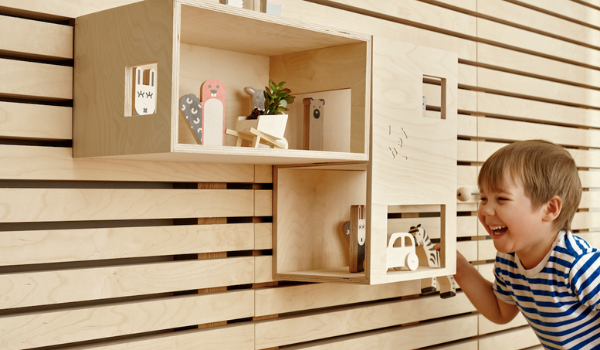
Imagine you are building a house. You make detailed plans for the study with specifications about how big the room should be, where the desk should go and the size of the windows. As for the rest of the house, you leave that to the architects. When the house is complete, the study is fantastic, but the other rooms are not nearly as useful. While they function well enough, they’re disconnected from the study you so lovingly designed. The house doesn’t feel like a home because you only focused on one room. It lacks the harmony you hoped for.
Similarly, when we approach a child’s education and focus solely on academic abilities, that child does not develop the complete set of skills they need to become a satisfied, successful adult. They may be able to read and write, but what about expressing emotions and taking care of their bodies? Such skills do develop naturally, to some extent. But children won’t reach their full potential without an education that addresses all areas of holistic development.
Simply put, holistic development is the social, emotional, physical, mental, and intellectual growth of a person. Taking a holistic approach to education means focusing on all aspects of a child’s growth, not just their academic advancements. Most importantly, it’s about establishing the child’s overall wellbeing.
Without wellbeing, learning becomes impossible. Imagine if your head hurt, but you had to learn about history. Or if you felt fatigued, but you had to find the square root of 529. Would you be willing to learn? Probably not. The same is true of children. They must feel healthy, safe, and cared for - only then are they able to learn effectively.
In this article, you will find the following sections:
- The Processes & Periods of Holistic Development
- Social-Emotional Development
- Physical Development
- Cognitive Development
- Linguistic Development
- Holistic Development Leads to Transversal Skills
The Processes & Periods of Holistic Development
Holistic development encompasses three processes: biological, cognitive and social-emotional.
The biological process involves bodily changes, like brain development, physical growth and weight increases. It’s how small people physically transform from children to adults.
The cognitive process includes thinking, intelligence and language skills. It’s how the youngest members of society intellectually graduate from simple to complex ways of thinking.
The social-emotional process comprises personality, emotions and interpersonal connections. It’s how individuals’ behaviors progresses from childish to mature.
The three processes influence and impact each other and none are mutually exclusive. For example, a child responds to their parent’s loving touch by feeling the sensation (biological), understanding the intention (cognitive) and reacting positively (social-emotional).
In child development, there are four sequential periods of growth:
- prenatal (from conception to birth)
- infancy and toddlerhood (from birth to 18-36 months)
- early childhood (from 3 years to 5-6 years)
- middle or late childhood (6 years to 11 years)
Each period involves developmental milestones, which are common behaviors or skills typical of the age. There is, however, variation among children. Not all children will hit the same milestones at the same time because every child is unique. To best foster holistic growth, adults working with children should be aware of these milestones. We’ll share a few examples of the infancy & toddlerhood and early childhood periods with you here because that’s our area of expertise!
One more thing to note: holistic development is different from holistic learning. Development refers to the more ‘passive’ biological aspects of growth. For example, all humans without developmental challenges gradually learn to walk without being taught. Learning, on the other hand, indicates something active or intentional that a person can practice or someone else can teach them, such as learning to read. In this article, we discuss holistic development with some examples of how to encourage holistic learning.
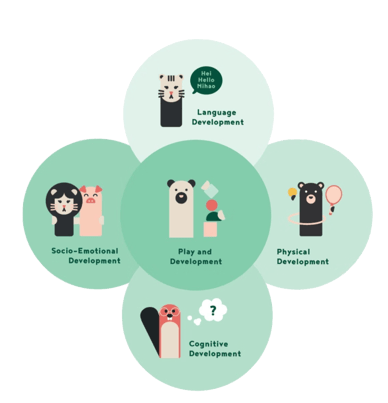
The four interconnected areas of children’s holistic development and learning are social-emotional, physical, linguistic and cognitive development. We’ll explain what each of them encompasses, as well as milestones, examples and ways you can encourage growth in each area!
Social-Emotional Development
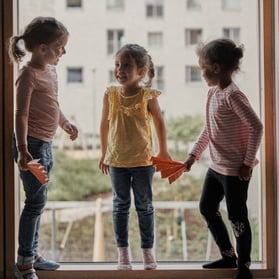 Social-emotional development involves the development of a child’s emotional wellbeing, identity, independence, cooperation and interaction skills, and it’s the basis of all other learning. Once children have confidence, they feel empowered to learn anything.
Social-emotional development involves the development of a child’s emotional wellbeing, identity, independence, cooperation and interaction skills, and it’s the basis of all other learning. Once children have confidence, they feel empowered to learn anything.
This aspect of holistic development naturally begins from the time a baby is born. They interact with and create an attachment to their caregivers, which forms the foundation for all other relationships in life. As mentioned previously, establishing a child’s wellbeing is the first step for learning. Without safety and trust, children cannot learn. You can build trust by giving children consistent routines (and being able to venture outside those routines occasionally), respect, and freedom to explore safely.
Social-emotional development includes:
- The ability to express and understand emotions
- The ability to form caring and secure relationships
- The possibility to experience life in a positive and healthy way
- The development of emotional wellbeing
If you’ve ever noticed that children of the same age vary in their social-emotional skills, that’s perfectly normal. In fact, there’s a factor that accounts for this phenomenon, and it’s called temperament. A child’s temperament affects their ability to control emotions or respond to the things around them. It explains the differences in children’s personalities, behavior styles, emotional reactions, and responses that you naturally observe as an adult.
For example, a child might be “easy,” “slow to warm up,” or “difficult.” However, no child is actually “difficult,” but the environment, including the adult who finds them difficult, simply does not match the child’s temperament type. “Goodness of fit “ describes this phenomenon, and it’s important to be aware of it. Temperament is part of what makes each child unique, and learning the characteristics of their temperament will help you understand their individuality and ways to support them.
Milestones of social-emotional development
The milestones for social-emotional development in the broader framework of holistic development include the following:
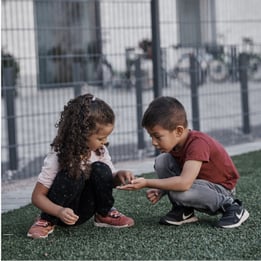
Infancy & Toddlerhood
- Gets comfortable with daily routines
- Expresses primary emotions (joy, anger sadness)
- Responds to own name and becomes aware of self as separate from others
- Establishes warm relationships with adults and shows interest in other children
Early childhood
- Moves and explores freely and follows daily routines
- Expresses larger range of emotions and can recognize their own and other’s feelings
- Expresses own interests and shows increasing independence
- Can participate in group activities and starts to form and develop friendships
Ways to promote social-emotional development
There are many ways you can promote children’s social-emotional development. First and foremost, you can be an active role model of healthy social-emotional skills. Your example is extremely powerful in promoting children’s holistic development. Other ways to encourage their growth include the following: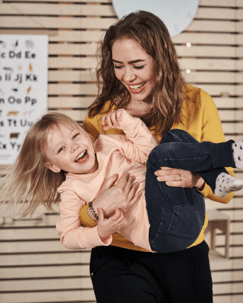
- Establish warm and caring relationships with children - smile, respond to children’s initiatives, talk in a calm voice, and comfort children in need.
- Help children understand that all emotions are acceptable, including negative feelings.
- Encourage children's participation and agency by giving them responsibilities or asking for their opinions.
- Engage in activities and support children when they interact with each other.
- Establish group rules with children and help them understand how their negative behavior affects the children around them.
- Discuss and agree on how to resolve conflicts and ask for children’s ideas and opinions.
- Offer encouragement and reinforcement for appropriate behaviors.
Part of social-emotional development is learning how to work through challenging emotions. Professor Lasse Lipponen will provide some pedagogical insights in our webinar, “How to Discuss Difficult Topics with Children”, which is available as an on-demand recording!
Physical Development
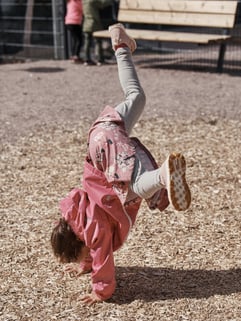 Physical development is another major area of holistic development. It can be broken into two categories, namely, the development of gross motor skills and the development of fine motor skills. While every child is different, gross motor skills development typically occurs first. Fine motor skills, which require control and dexterity in the hands and fingers, come later.
Physical development is another major area of holistic development. It can be broken into two categories, namely, the development of gross motor skills and the development of fine motor skills. While every child is different, gross motor skills development typically occurs first. Fine motor skills, which require control and dexterity in the hands and fingers, come later.
Gross motor skills involve the use of large muscles and body parts, like the arms and legs. Running, jumping, balancing and dancing are some examples of gross motor skills in action. For a typically developing child, active movement and freedom to explore their daily environments helps them develop these skills.
Fine motor skills, on the other hand, refer to small muscle movements in parts of the body like the fingers, toes and feet. Combining the senses with movement, what we call perceptual motor skills, fall under this category. Hand-eye coordination, which builds the foundation for writing and drawing, is one such example, and tthere are many more daily activities that require these skills.
Milestones of physical development
The following are some milestones of physical development. Keep in mind that physical development, like any other area of holistic development, varies with each child. Therefore, the milestones provided below are guidelines, not rules, for typical child development.
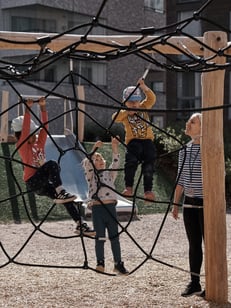
Infancy & Toddlerhood
- Rolls over, crawls independently
- Starts walking, running and climbing
- Picks up toys and passes them from hand to hand
- Opens drawers and closets
Early Childhood
- Improves coordination and balance
- Throws and learns how to catch balls
- Learns how to grasp crayons and draw
- Manipulates small objects
Ways to promote physical development
Children grow rapidly during early childhood, which is why it’s important to let them move in a variety of ways. In the early education setting, this means giving them outlets for free movement and exploration, thereby developing gross motor skills, and providing more guided activities to help them develop fine motor skills. More examples include the following:
- Offer a variety of sports, like football, basketball, baseball, tennis and so on.
- Play music and encourage children to dance, clap, stomp their feet and play percussions on their bodies.
- Provide a wide range of activities, toys and materials that let children practice more refined movements. For example, drawing supplies, beads and string, child-safe scissors, puzzles, blocks and play dough all require fine motor skills. Switch out what you offer as well so they can try different forms of small movement.
Cognitive Development
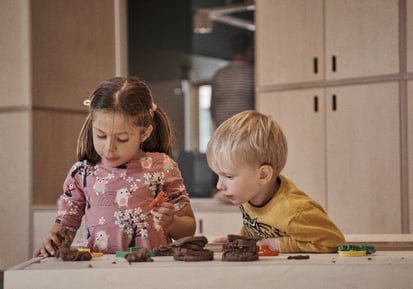 Cognitive development is the area that traditional academic settings address most proactively, and it’s one that still needs care and attention no matter the setting. Each cognitive function activates a certain part of the brain, which helps a child understand and make meaning of the world. Like other areas, children develop their cognitive abilities at different paces, which is determined by inborn preferences and previous experiences.
Cognitive development is the area that traditional academic settings address most proactively, and it’s one that still needs care and attention no matter the setting. Each cognitive function activates a certain part of the brain, which helps a child understand and make meaning of the world. Like other areas, children develop their cognitive abilities at different paces, which is determined by inborn preferences and previous experiences.
There are 4 main categories within this area of holistic development, namely attention, thinking, memory and learning.
- Attention is the process in someone’s mind that allows them to orient themselves towards stimuli that are relevant and ignore those that are not.
- Thinking is the process of transforming and manipulating information in one’s memory in order to reason, solve problems or make decisions.
- Memory is the capacity to retain information over time. Processing information includes three stages: encoding (getting information into memory), storage (retaining information over time) and retrieval (taking information out of storage).
- Learning is the change in a person’s knowledge or behavior due to new knowledge or experiences. Learning happens all the time, even in our sleep!
Milestones of Cognitive Development
Like previous milestones, the following examples of cognitive development vary with each child. If there is a cause for concern in the area of cognitive development, it is important to bring in experts like child psychologists to assess and diagnose any problems a child might have.
Infancy & Toddlerhood
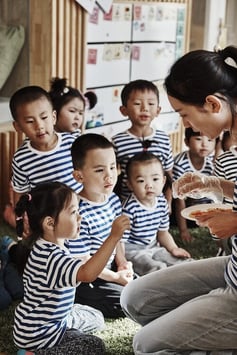 Increases attention span to a few minutes at once and demonstrates joint attention (focusing on something together with others)
Increases attention span to a few minutes at once and demonstrates joint attention (focusing on something together with others)- Starts to remember previous experienceswith the help of an adult
- Gets familiar with the environment and explores through moving, touching and mouthing
- Develops spatial thinking and gets familiar with expressions of time and space
Early Childhood
- Pays attention to an activity for 5 minutes or more and then as long as needed
- Recalls stories, rhymes and develops memory capacity of 4-5 units
- Demonstrates an ability to connect ideas and identifies concepts like colors, textures, etc.
- Makes mathematical observations like counting, comparing sizes and recognizing shapes and small number amounts
Ways to Promote Cognitive Development
The traditional academic approach includes many methods to promote this area of holistic development. There are, however, a variety of ways you can playfully promote cognitive development in the early childhood education setting.
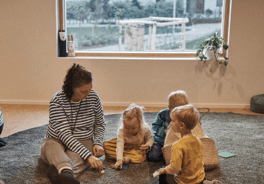 Provide a versatile learning environment and make changes in the environment regularly for the children to observe and notice.
Provide a versatile learning environment and make changes in the environment regularly for the children to observe and notice.- Discuss various topics with children and ask open-ended questions.
- Encourage independent problem-solving and decision-making - do not give ready-made answers.
- Play games that support cognitive development: memory games, puzzles, card games, hand games, reading, singing, and rhyming.
- Utilize play-based activities, hands-on learning and thematic projects that let children engage with the learning
You can playfully implement STEAM learning and foster children's mathematical skills as well!
Linguistic Development
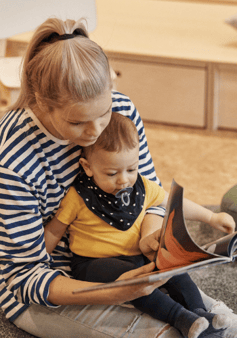 Linguistic development is the last main area of holistic development. In short, it is a process by which children learn to use and understand a language. It starts with listening and understanding. Babies begin this process by paying attention to the face of their caregiver and recognizing language sounds. Then they start to connect words with meaning in familiar contexts. Linguistic development includes language listening and comprehension, language production and literacy skills.
Linguistic development is the last main area of holistic development. In short, it is a process by which children learn to use and understand a language. It starts with listening and understanding. Babies begin this process by paying attention to the face of their caregiver and recognizing language sounds. Then they start to connect words with meaning in familiar contexts. Linguistic development includes language listening and comprehension, language production and literacy skills.
- Language listening and comprehension is a child’s ability to understand and make sense of spoken language. It includes recognizing speech, single words, phrases, sentences and grammar structures.
- Language production refers to a child’s ability to communicate using pre-verbal (e.g. sounds or short vocalizations) and verbal expressions (e.g. words or sentences).
- Literacy skills include the development of oral language skills and getting familiar with different narrative structures. It also comprises phonological skills such as learning about letters and sounds.
Milestones of linguistic development
The following are some major milestones of language development in typical childhood development.
Infancy and Toddlerhood
- Recognizes words in daily life and connects heard word with certain object or action
- Communicates using non-verbal sounds and imitates different sounds
- Enjoys listening to songs, rhymes and stories
Early Childhood
- Understands increasingly complex spoken language and asks for the meaning of works
- Carries out conversations and uses sentences with multiple words
- Starts to produce own texts through playful writing
Ways to support linguistic development
Young children have an astonishing capacity for learning language. As such, their language skills develop rapidly in this area during their first few years of life. The following are some ways to encourage this area of holistic development: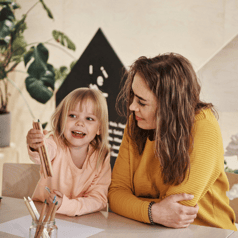
- Interact with children and talk to them as much as possible. Use rich vocabulary and introduce new words on a regular basis.
- Support language learning by using pictures and pictograms.
- Verbalize actions, objects or feelings constantly.
- Use music activities, drama and movement to support language development like songs, rhymes and puppet theater.
- Ask open-ended questions instead of “yes or no” questions. This encourages children to speak.
- Encourage children to speak, describe things and ask and answer questions and share their stories.
- Support language learning with positive feedback.
Holistic development leads to transversal skills
When an educational approach incorporates holistic development, it brings together all the aspects of a child’s growth. This, in turn, develops children’s transversal skills, which are a broad set of skills, work habits, character traits and knowledgeable insights. Examples include empathy and compassion, creative thinking, teamwork, problem-solving, self-expression, multi-literacy, and independence. Being able to connect seemingly disparate subjects, create innovative solutions and carry out complex projects are the results of a holistic education.
If you design a house well and keep all of the rooms in mind, it will become a warm, welcoming home. Similarly, if you educate a child fully and promote their holistic development, they will become a happy, healthy human. It’s all about recognizing the range of developmental needs and addressing each area through high-quality education and care.
Learn how to foster holistic development in the early childhood education and care setting with our HEI Schools Teacher Diploma program. Available to any educator or parent around the world, the course teaches you how to put these skills into practice.






.jpg?width=352&name=how%20HEI%20Curriculum%20helps%20you%20to%20achieve%20Indias%20NEP%20(2020).jpg)